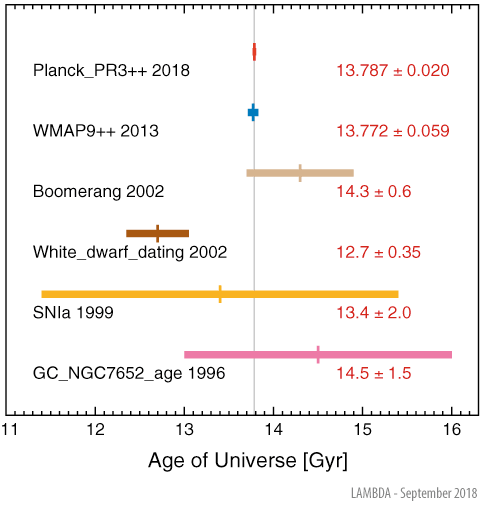

Age of the UniverseA variety of reasonably independent methods for determining the age of the universe are available, but none of course are a direct measurement: each rely on certain modeling assumptions. Data in the figure below are only representative of the numerous results in the literature. Many published results have centered on the use of stellar evolution theory, finding the oldest stars (generally in metal poor globular clusters) to obtain a lower limit on the age, and then assuming a cluster formation time in order to achieve an estimate of t0. See numerous references in Spergel et al. (2003) for discussion. In this category, we have chosen to show the Hubble Space Telescope (HST) determination of the age of globular cluster NGC 7652 (Renzini et al. 1996) and the white dwarf dating results of Hansen et al. (2002) and Richer et al. (2002). These are representative only: globular cluster ages in particular have shown a fairly wide range in values (Chabdoyer & Krauss 2002). Ages obtained through the use of cosmological models are represented by the CMB results of Boomerang, WMAP and Planck, as well as an early result from the Supernova Cosmology Project (Perlmutter et al. 1999). The SNIa result comes from application of the FLRW magnitude-redshift relation to derive 2-d confidence regions within the Ωm- ΩΛ plane, and subsequently integrate over these parameters to obtain an estimate of the age in units of h. We quote a value from this paper assuming h=0.70 and a flat universe. The Boomerang, WMAP and Planck results are from fits of ΛCDM models to CMB power spectra. Boomerang's limited sky coverage restricted its available multipole range. The nine-year WMAP and 2015 Planck results draw not only from their respective mission data, but also include constraints from multiple external datasets (SNIa, BAO, small-scale CMB observations from ACT and SPT), as such they are not completely independent determinations from each other. There is good agreement among the CMB results, but note that the exact value of t0 is somewhat model dependent.  Image Credit: NASA / LAMBDA Archive Team Lower limits on the age of our universe, t0, may be obtained by estimating the ages of the oldest observable objects. Ages determined in this fashion tend to rely on stellar evolution theory, rather than an assumption of a cosmological model such as ΛCDM. Two representative values are shown, based on cool white dwarfs and the oldest stars in globular clusters, but note that results obtained in this fashion have produced a range of estimates between roughly 12-16 Gyr (Spergel et al. 2003). Within Big Bang cosmologies, t0 refers to the time interval since the Big Bang up through the present. The computed value is somewhat dependent of the exact cosmological model assumptions. Within the standard ΛCDM model framework, CMB measurements, combined with BAO and SNIa measurements of the expansion rate, are presently in agreement and tightly constrained. The gray vertical line, representing the weighted average of WMAP and Planck data points, is positioned at t0 = 13.785 Gyr.
Contributed by the NASA / LAMBDA Archive Team. |

